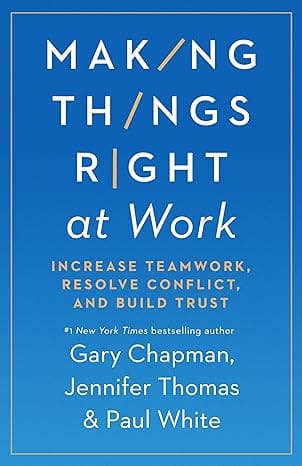- Home
- Relationships
- Why Conflict Happens

Why Conflict Happens
 Excerpt Taken from Making Things Right at Work: Increase Teamwork, Resolve Conflict, and Build Trust by Gary Chapman, Jennifer Thomas, and Paul White
Excerpt Taken from Making Things Right at Work: Increase Teamwork, Resolve Conflict, and Build Trust by Gary Chapman, Jennifer Thomas, and Paul White
BUT WHY CONFLICT? Where does it come from? Let’s zero in on actual people and offenses. Like any good problem solving, specifying what the actual “problem” is and where it is coming from is the first step. So what about our example in the Introduction—the employee (we’ll call her Kaylie) who felt demeaned when her boss (we’ll call her Lori) seemed to dismiss and almost laugh at her idea in the meeting?
Kaylie needs to remember that the symptoms (Lori being dismissive) are not necessarily the problem. When you have an aching back, you can take some painkillers. But until you address the issue causing the pain, the symptom will probably return. So the first question to try to answer is why is Lori relating to Kaylie differently? Putting it another way, why is Kaylie feeling hurt by her boss, with whom she has gotten along well and who has always given her stellar reviews?
All or Nothing?
In general, Kaylie and Lori enjoy a solid working relationship. They don’t socialize after hours or even have lunch together except for work functions. Lori is married with kids, a few years older than single Kaylie. But they get along. Then there’s Sam, another of Lori’s direct reports. He’s hard for Kaylie to like—overly chatty and jokey. But he gets his work done and is never offensive or inappropriate, so she tolerates his dad jokes.
We need to remind ourselves that having problems with someone is not an “all or nothing” experience. It’s not a choice of cherished confidant or nameless stranger. The quality and level of our relationships exists on a continuum, as do the challenges in those relationships. Some people may irritate us a little bit. Others we really enjoy—but only up to a point, and then we need a break from them.
We seem to be able to communicate clearly and easily with some people at work, while there are others who we don’t “get,” and they don’t get us. Coming to the point where we understand one another takes a lot of time and effort (and sometimes doesn’t seem worth it!).
Within the context of work relationships, we may have a colleague who becomes a close friend we enjoy spending time with outside of work. We probably have coworkers we’re not close to, but we work together well. Sometimes a colleague (or a supervisor or someone we supervise) rubs us the wrong way because of our significant differences in personality and communication styles. And then there are those we either actively dislike or have a past conflict that continues to cloud our relationship.
Finally (and hopefully they are rare), there may be people in the organization you don’t feel safe around, or with whom you have serious differences about important things. You might choose to minimize your contact with them. If at all possible, these people should not be in a direct reporting relationship with you. If this is the case, work to make changes until you can honestly say that you have a positive relationship with all of your supervisors and supervisees.
Temporary “Breaks”
But even the most positive workplace relationships can be fractured by a temporary “break” in the relationship—maybe not a complete break where you don’t relate at all, but clearly tension, mistrust, or hurt has come between you two. What causes such fractures?
Misunderstanding / Miscommunication
Probably the most common source of challenges in workplace interactions comes from simple misunderstanding and miscommunication. Mishearing (literally, not accurately hearing what the other person said) and misinterpreting the message they intended to send are the reason so much training in communication and “active listening” is foundational to workplace functioning.
One of the best ways to avoid this type of miscommunication is to confirm that you understand the message sent and the practical implications (that is, what is expected of you in response). Simply summarizing what you’ve heard (“What I hear you saying is … and you want me to … ”) is an excellent tool to use consistently when communicating with your coworkers and superiors. It could be Kaylie, for whatever reason, misheard or certainly misinterpreted Lori—or the other way around.
Differing Viewpoints / Perspectives / Opinions / Preferences
Some conflicts are the result of honest differences with others. These are normal, and in many cases healthy, providing a variety of viewpoints and reflecting the wide range of backgrounds and values in our culture and the growing diversity of our workforce.
Real-life examples include:
• One of your team members disagrees with you regarding the direction the marketing plan should go.
• You disagree with some of your coworkers on the role of government in helping people.
• Your boss comes from an older generation. His preferences for the colors, fonts, and images that he wants to use in branding the company vary widely from your and your colleagues’ ideas.
Dissimilar Personality and Communication Styles
Relational challenges frequently derive from distinct personality styles and their associated communication patterns. A myriad of personality typologies have been developed that describe people’s personality traits in a variety of categories. These approaches can focus on interpersonal energy (introversion/extroversion); inner motivations that drive behaviors (the Kolbe Index, the Enneagram); ways of perceiving the world around them (the Myers Briggs Type Indicator); how they approach tasks (the DISC); and many other ways of assessing personality traits.1
Think about the problems that can ensue when you have two department heads working together on a project. One has a strong, forceful, in-your-face style, while the other is more soft-spoken, waits to talk until there is “space” open in the conversation, and tends to avoid confrontational interactions. Without significant help—say, from a third person in the mix—they may
have trouble making decisions and accomplishing tasks, simply because of who they are and what their communication styles are.
We need a diverse array of personality types in a work setting to avoid the dangers of “groupthink.” At the same time, continually wrestling through these differences can be stressful and draining. We perceive events differently, bring divergent values to bear on a situation, react differently to challenges, and communicate our views and beliefs in distinctive ways. This is why most of us prefer to be around others seemingly “like us”—it’s just easier. The downside is that, when everyone has a shared viewpoint, we can collectively make wrong decisions without the “team of rivals” effect of varied opinions and backgrounds.
Unintentional Mistakes
We all make mistakes. We forget to complete a task. We don’t remember to include all relevant team members on an important email. We accidentally hit “reply all” and copy too many team members on an email that contains negative information about an employee. Some of us share our thoughts and opinions before fully thinking them through. We write down the wrong date for a meeting or a deadline. We’re too hasty in reviewing the numbers on a financial report. We may draw an erroneous conclusion from information we’ve heard before fully checking out the actual facts (and context) of a situation. The potential examples are almost as numerous as the number of decisions made in daily work life.
There are also intentional errors—we discuss those below.
The problem is, most of the time when an employee makes a mistake (regardless of intent), someone else is affected negatively. The error provides inaccurate information from which a decision is made. The miscommunication may create a false perception of a person, company, or product. Just as good decisions are built upon accurate information, poor decisions are often the consequence of inaccurate data and perceptions. And poor decisions may affect the health of the organization, your vendors, your customers, and the community at large.
Who is to blame when unintentional mistakes occur? No one, really. Mistakes happen, and playing the blame game doesn’t help. What does? Identifying how the mistake happened, piecing together who (or what process) is responsible for some parts of the error occurring. This leads to determining what corrective steps need to be taken toward those affected, and provides direction on what steps can be taken to try to prevent a similar mistake happening in the future.
Feeling Offended or Disrespected
When you (or someone in your organization) feels offended or disrespected by someone, we would argue that assuming that the “offending” party did something wrong is not the best place to start. Why? Because sometimes people become offended when nothing improper was actually done.
Our response of feeling offended or disrespected comes from the experience of not feeling treated appropriately by someone. They either did something we think they “shouldn’t have” (refer to the boss as “Jim” versus “Mr. Atkins”), or they didn’t do something we think they should have (copy you on an email regarding an issue that affects you and the department you oversee). Or, as we saw earlier, feeling put down in some way, as happened with Kaylie and her boss.
Since each of us carries around myriad unspoken expectations, often shaped by deep-rooted values, innumerable opportunities to offend or feel offended arise every day, especially in new situations where the workplace culture and social norms are still developing. This also happens when teammates from different cultures are interacting.
From our work with the five languages of appreciation in the workplace, we have learned that people are also more sensitive to various modes of communication based on their preferred appreciation language. For example, a colleague who values Quality Time may feel hurt when they are not invited to go to lunch with the rest of the team. Or a coworker for whom Words of Affirmation are important may be more sensitive to verbal correction than generally would be expected.
Wrong Choices and Inappropriate Actions
A final category of actions needs to be discussed—when someone (you, your colleague, a supervisor) actually makes a poor choice. The action or reaction displayed clearly falls below the commonly accepted standard of what is appropriate for that situation. Usually the “appropriateness” of the action is defined by relevant societal norms or according to the organizational culture, but can also be influenced by an individual’s cultural background, their personal experiences, and their own values and priorities.
The range of behaviors that are viewed as inappropriate are almost limitless, but let us share a few common examples we have observed and/or experienced (or done ourselves):
• A leader “calling out” a team member in front of others for not getting a task done on time or at the expected quality level, using an intense tone of voice and derogatory language (“I can’t believe you were so stupid to believe that is what we wanted for this presentation.”).
• Not understanding the expectations for the type of clothing to wear to an event and creating embarrassment for your boss, organization, and yourself. This can take the form of either being noticeably underdressed—wearing shorts, t-shirt, and sandals to a more formal event where slacks, a collared shirt, and leather shoes are expected. Or misunderstanding what “formal attire” means in your company’s (or industry’s) culture—a coat and tie are expected for men and a nice dress or business suit for women, not a tuxedo or a full-length, high-society formal gown.
• When a presentation doesn’t go well, lying to your supervisor about your role and responsibility, placing blame on a colleague.
These actions, in different ways, cross boundaries of what is permissible and understandable. To a degree, “what’s permissible” may vary according to your own company’s culture or industry norms. Dressing inappropriately may be a minor gaffe, easily remedied, in one organization; in another, it may be viewed as a major faux pas. On the other hand, throwing a teammate under the bus, or public shaming of someone, could have very serious repercussions—for you, not them.
Whatever the infraction, whatever the line that is crossed, you will need to make things right and perhaps repair a relationship. Later in this book we will look at the role apologies may play in the workplace.
…
Order your copy of Making Things Right at Work: Increase Teamwork, Resolve Conflict, and Build Trust by Gary Chapman, Jennifer Thomas, and Paul White
Trending Now
Sign up today for your Inspiration Today Daily Newsletter
Supercharge your faith and ignite your spirit. Find hope in God’s word. Receive your Inspiration Today newsletter now!
Gary Chapman
Gary Chapman, Ph.D. is the bestselling author of The 5 Love Languages® series and director of Marriage and Family Life Consultants, Inc. Gary travels the world presenting seminars, and his radio program airs on more than 400 stations. Learn more at www.5lovelanguages.com
Related Articles
June 27, 2025
Who Is My Neighbor: Bridging the Gap Between Emancipation and Equality (Part 2)
In “Who Is My Neighbor: Bridging the Gap,” we ask what it means to truly see, hear, and love our…
June 24, 2025
It’s All About Love
This excerpt explores the beauty of God’s design for marriage, showing how Scripture reflects His…
June 10, 2025
Freedom in Forgiveness
This excerpt explores the healing process and power of forgiveness in marriage, emphasizing how it…
June 2, 2025
The Mystery of Marriage
This excerpt explores the mystery of marriage as a divine reflection of Christ’s love for the…
Next Steps To Strengthen Your Walk
Inspiration Today Newsletter
Supercharge your faith and ignite your spirit. Find hope in God’s word. Receive your Inspiration Today newsletter now!
Christian Articles
Find articles to strengthen your walk and grow your faith. We have a wide range of topics and authors for you.
Submit A Prayer Request
We are here for you. Simply click on the button below to reach us by form, email or phone. Together we will lift our hearts and voices with you in prayer.





